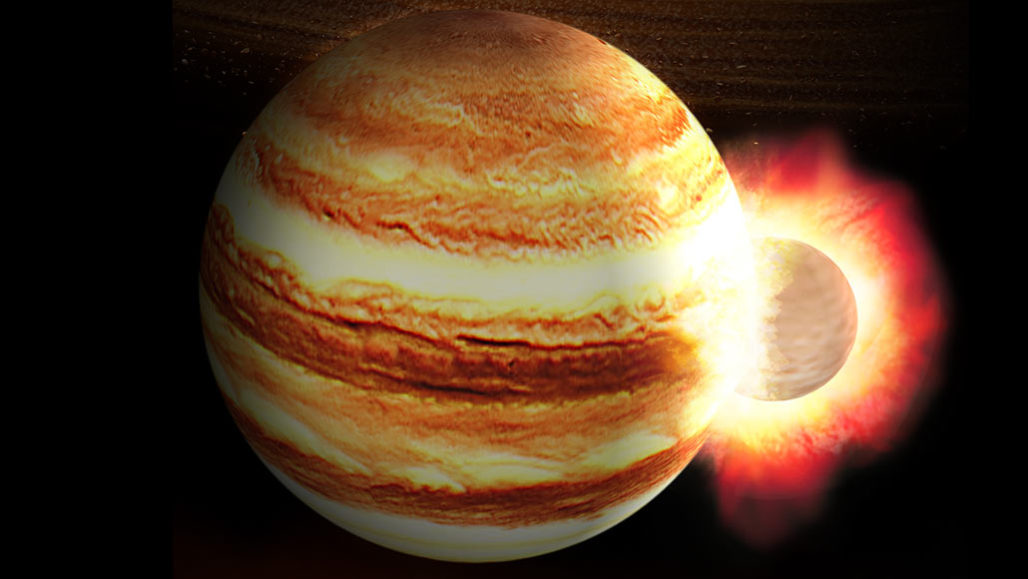 |
| WRECKING BALL |
A planetary smashup billions of years ago may be to blame for Jupiters wierdly puffy core.
Recent measurements of Jupiter's gravitational field indicate that, rather than a dense pit of rock and ice, Jupiters core is a haze of heavy element possible spanning half the plannet's radius. That observation, made by NASA's Juno spacecraft that started orbiting Jupiter in 2016, flies in the face of current planet formation models. Those models suggest that Jupiter would have formed from a dense kernel that accumulated a thick envelope of gas.Recent measurements of Jupiter's gravitational field indicate that, rather than a dense pit of rock and ice, Jupiters core is a haze of heavy element possible spanning half the plannet's radius. That observation, made by NASA's Juno spacecraft that started orbiting Jupiter in 2016, flies in the face of current planet formation models. Those models suggest that Jupiter would have formed from a dense kernel that accumulated a thick envelope of gas.Recent measurements of Jupiter's gravitational field indicate that, rather than a dense pit of rock and ice, Jupiters core is a haze of heavy element possible spanning half the plannet's radius. That observation, made by NASA's Juno spacecraft that started orbiting Jupiter in 2016, flies in the face of current planet formation models. Those models suggest that Jupiter would have formed from a dense kernel that accumulated a thick envelope of gas.
Recent measurements of Jupiter's gravitational field indicate that, rather than a dense pit of rock and ice, Jupiters core is a haze of heavy element possible spanning half the plannet's radius. That observation, made by NASA's Juno spacecraft that started orbiting Jupiter in 2016, flies in the face of current planet formation models. Those models suggest that Jupiter would have formed from a dense kernel that accumulated a thick envelope of gas.
Recent measurements of Jupiter's gravitational field indicate that, rather than a dense pit of rock and ice, Jupiters core is a haze of heavy element possible spanning half the plannet's radius. That observation, made by NASA's Juno spacecraft that started orbiting Jupiter in 2016, flies in the face of current planet formation models. Those models suggest that Jupiter would have formed from a dense kernel that accumulated a thick envelope of gas.
Recent measurements of Jupiter's gravitational field indicate that, rather than a dense pit of rock and ice, Jupiters core is a haze of heavy element possible spanning half the plannet's radius. That observation, made by NASA's Juno spacecraft that started orbiting Jupiter in 2016, flies in the face of current planet formation models. Those models suggest that Jupiter would have formed from a dense kernel that accumulated a thick envelope of gas.
Recent measurements of Jupiter's gravitational field indicate that, rather than a dense pit of rock and ice, Jupiters core is a haze of heavy element possible spanning half the plannet's radius. That observation, made by NASA's Juno spacecraft that started orbiting Jupiter in 2016, flies in the face of current planet formation models. Those models suggest that Jupiter would have formed from a dense kernel that accumulated a thick envelope of gas.
Recent measurements of Jupiter's gravitational field indicate that, rather than a dense pit of rock and ice, Jupiters core is a haze of heavy element possible spanning half the plannet's radius. That observation, made by NASA's Juno spacecraft that started orbiting Jupiter in 2016, flies in the face of current planet formation models. Those models suggest that Jupiter would have formed from a dense kernel that accumulated a thick envelope of gas.



2 Comments
Comment test. Comment test. Comment test. Comment test. Comment test. Comment test. Comment test. Comment test. Comment test. Comment test. Comment test. Comment test. Comment test. Comment test. Comment test. Comment test. Comment test. Comment test. Comment test. Comment test. Comment test. Comment test. Comment test. Comment test. Comment test. Comment test. Comment test. Comment test. Comment test. Comment test. Comment test. Comment test. Comment test.
ReplyDeleteOk, It's working
ReplyDelete